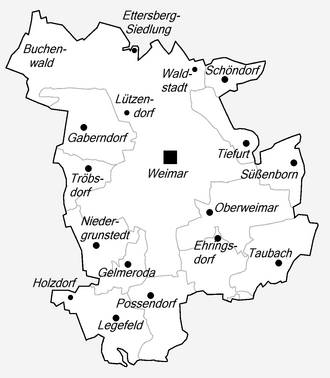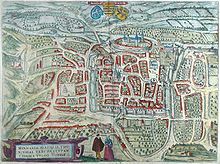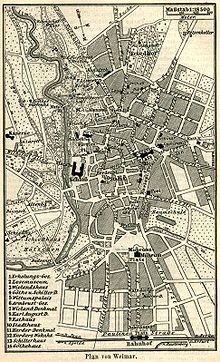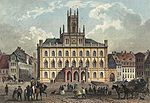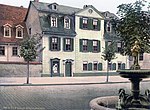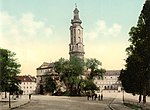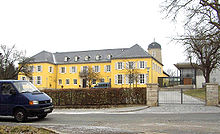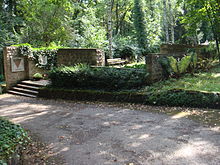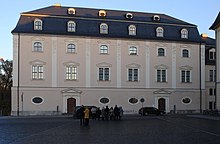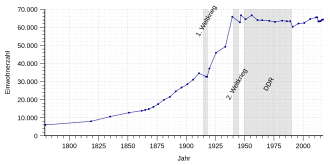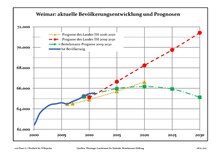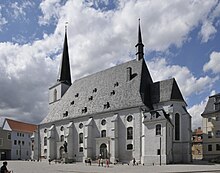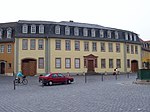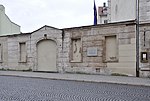Weimar
| coat of arms | Germany map | |
|---|---|---|

|
Coordinates: 50 ° 59 ′ N , 11 ° 20 ′ E |
|
| Basic data | ||
| State : | Thuringia | |
| Height : | 208 m above sea level NHN | |
| Area : | 84.48 km 2 | |
| Residents: | 65,098 (Dec. 31, 2020) | |
| Population density : | 771 inhabitants per km 2 | |
| Postcodes : | 99423, 99425, 99427, 99428 | |
| Primaries : | 03643, 036453 | |
| License plate : | WE | |
| Community key : | 16 0 55 000 | |
| LOCODE : | DE WMR | |
| NUTS : | DEG05 | |
| City structure: | 12 districts | |
City administration address : |
Schwanseestraße 17 99423 Weimar |
|
| Website : | ||
| Lord Mayor : | Peter Kleine (independent) | |
| Location of the city of Weimar in Thuringia | ||
Weimar is an independent city in Thuringia in Germany , which is known for its cultural heritage. The middle town is located on an arch of the Ilm, southeast of the Ettersberg , the highest mountain in the Thuringian Basin at 478 meters . The city is the fourth largest in Thuringia after Erfurt , Jena and Gera and is about halfway between Erfurt in the west and Jena in the east.
Weimar is a medium- sized center that fulfills partial functions of a regional center and has been a university town since 2004 . In addition to the Bauhaus University , the city is home to the Liszt University of Music and the Duchess Anna Amalia Library , as well as authorities such as the Thuringian Higher Administrative Court , the Thuringian State Administrative Office , the Thuringian Constitutional Court and the Thuringian State Office for Monument Preservation and Archeology .
In the 16th century the painters Lucas Cranach the Elder and the Younger worked in Weimar. The fruit-bearing society was founded in the 17th century . Johann Sebastian Bach stayed in the 18th century . This is followed by the Weimar Classic with Wieland , Goethe , Herder and Schiller . The 19th century is associated with Franz Liszt , Richard Strauss , Friedrich Nietzsche and the landscape painters of the Weimar School of Painting at the Grand Ducal Saxon Art School . Harry Graf Kessler and Henry van de Velde worked in Weimar at the beginning of the 20th century, and the Bauhaus and Weimar Republic were founded .
The UNESCO declared the Bauhaus sites in Weimar and Dessau in 1996 and the " Classical Weimar " in December 1998 to the World Heritage Site . In addition, Goethe's legacy, stored in the Goethe and Schiller Archive in Weimar, was included by UNESCO in the cultural memory of mankind in 2001 as a world document heritage (Memory of the World). Since 2015, early writings of the Reformation have also been part of the world document heritage, some of which are kept in the Duchess Anna Amalia Library in Weimar. The national and international cultural heritage is presented in over 25 museums and exhibition venues.
Weimar had been the capital and residence of the Duchy of Saxony and Saxony-Weimar from 1547/52 , later Saxony-Weimar-Eisenach (from 1815: Grand Duchy ). In 1816 this became the first state in Germany to adopt a constitution . Parallel to the session of the National Assembly from February 6, 1919 to September 1919, Weimar was temporarily the seat of government of the Weimar Republic, which was being constituted . From 1920 to 1952 Weimar was the capital of the state of Thuringia . In 1999 it was the European Capital of Culture .
geography
Weimar is around 200 meters above sea level in the middle of Thuringia. The Ilm runs through the city in an arc. It enters the urban area near Taubach in the southeast, flows on through Oberweimar and the old town, before it leaves the urban area in a northeastern direction below Tiefurts. To the west extends from the Ilm valley to the Thuringian Basin . It is a fertile, gently undulating loess landscape in which the districts of Gaberndorf , Tröbsdorf and Niedergrunstedt are located.
The northern part of the city is occupied by the Ettersberg . At 482 meters, it is the highest mountain in the Thuringian Basin and extends for around eight kilometers from Ottstedt am Berge in the west to Schöndorf in the east. The Ettersberg is made up of mixed beech and oak forests. The Buchenwald concentration camp memorial is located on its top .
The Ilm-Saale-Platte rises in the southern part of the city , a dry, karstified shell limestone formation. It descends steeply towards the Ilm Valley, for example in Tiefurter Park . The red sandstone formation of the Tannrodaer saddle is located to the southwest outside the urban area . The highest elevations here are the 380 meter high Rosenberg and the 363 meter high Gelmerodaer Höhe. In this area, the federal motorway 4 runs between the districts of Gelmeroda , Holzdorf , Legefeld and Possendorf . The Belvederer Forst is the second forest area in the city next to the Ettersberg.
The extension of the urban area is 13 kilometers in north-south direction and around 9 kilometers in west-east direction. As part of the Thuringian chain of cities , Weimar is around 20 kilometers east of Erfurt and 20 kilometers west of Jena. Apolda is 15 kilometers northeast.
geology
Weimar is located in the center of the Thuringian Mulde, a sedimentary structure of the Zechstein and the Triassic . The near-surface geological subsurface of the city is characterized by the rocks of the shell limestone and the Keuper . Several faults in the urban area such as the Weimar Fault and the Oberweimar Fault, which run in a northeast-southwest direction, and ridges created by folding complicate the geological structure. Since the Middle Pleistocene, the Ilm has been flowing along the Ilmgraben, the depression created by the faults, and provided alluvial gravel there. Pleistocene and Holocene travertine and loess form cover layers, while solifluction tongues formed in the northwest direction during the Pleistocene glaciation . The Weimar urban area is rich in karst forms in the area of the shell limestone. As a result of the leaching of gypsum in the Middle Muschelkalk under the limestone of the Upper Muschelkalk, after the collapse of caves on the surface, bowl- to funnel-shaped karst depressions and sinkholes formed. Numerous examples can be found on the Ettersberg, southwest of Belvedere and south of Possendorf. In the Quaternary, during the Elster Glaciation, the southernmost ice edge area demonstrably extended to around Belvedere Palace. A memorial with a metal plaque was erected there to commemorate the location of the southernmost ice edge. Other "ice curbs" are also in other representative locations, e.g. B. in Gothaer Schlosspark. Erratic blocks and debris were found up to this line. Further north, only the Ettersberg remained ice-free. Due to the faults, numerous springs, some of which pour heavily, emerge at the edges of the Ilm Valley, such as the Leutra springs in the Ilmpark or the Herzquelle. For many years the city was able to supply itself from these sources.
Waters
Some smaller Ilm tributaries have been relocated several times since the Middle Ages, so that the original course can no longer be determined today. The Lottenbach , which comes from the Kirschbachtal in the (south) west, was divided within the urban area in order to supply various local businesses, including the Bornmühle, which was later demolished, with process water. Like the Asbach, the Lotte runs underground in the old town today. The Wilde Graben, which only had occasional water, was separated from the course of the Lotte and led through the former trench to protect the city center from flooding. The trench was also transformed into an underground canal in the 19th century.
climate
Due to its location, Weimar belongs to the vegetation zone of the deciduous deciduous forest in the humid climatic area . The local climate is influenced by the location "behind" the Ettersberg, which shields the city from the north and northwest. This makes the climate a little warmer and drier than in other regions of Central Thuringia. The average precipitation is 574 mm / year (DWD).
Urban area
The oldest settlement center in Weimar is the area between Graben, Schillerstraße and the City Palace with Herderplatz as the center. In the Middle Ages, the Jakobsviertel north of the moat up to Friedensstrasse was included in the city fortifications. In the 18th century the city grew beyond its medieval borders and the city walls were torn down. In the 19th and early 20th centuries, the city grew rapidly in different directions. Between the old town and the railway line, the north suburb was built around the main streets leading to Ettersburg and Buttelstedt , in the west between Schwanseestraße and Humboldtstraße the west suburb, in the south the south town between Berkaer Straße and Belvederer Allee . In the east, the Parkvorstadt was built along Jenaer Strasse. Due to the high proportion of civil servants and employees, there are mainly villas and townhouses and relatively few tenements in these quarters. Between the First and Second World War, the Ettersberg settlement was built five kilometers to the north. During the time of the GDR, there was hardly any population growth in Weimar. The prefabricated building areas Weimar-Nord on the Thuringian Railway , Weimar-West on the Berkaer Bahn and Schöndorf -Waldstadt north of the city on the Ettersberg were created. The commercial space is concentrated in the area behind the train station and, to a lesser extent, in the west near Erfurter Straße. New building areas emerged after 1990, especially in the newly added districts of Gaberndorf , Süßenborn and Legefeld . Some new industrial areas were created in the vicinity .
Weimar is divided into ten statistical districts in the core city and eleven incorporated districts. They are detailed in the list of districts of Weimar .
The neighboring communities of Weimar are all in the Weimarer Land district . They are named clockwise, starting in the northwest: Am Ettersberg , Ettersburg , Ilmtal-Weinstrasse , Umpferstedt , Mellingen , Vollersroda , Buchfart , Hetschburg , Bad Berka and Grammetal .
Protected areas
There are three designated nature reserves in the city area (as of January 2017).
history
prehistory
In Ehringsdorf , a district in the southeast of Weimar, the skeleton of the Ehringsdorf prehistoric man was found in 1925 , the age of which is estimated to be around 200,000 to 250,000 years. These are the fossil remains of a 20 to 30 year old woman. Human skull bones were discovered in the same quarry as early as 1908.
In a peat dig near Possendorf in 1850, a large, heavily worn copper kettle was found about 6 m deep, which had been repaired several times. Seven vessels were arranged around it. There was also an anthropomorphic wooden figure with tucked-in arms. Nearby was a large oak tree with a human skeleton. The cauldron was built between the 4th and 1st centuries BC. The only surviving clay vessel is dated from the 2nd to the 1st century at the turn of the century. Longer use of the space cannot be determined. It could be a ritual burial of cult implements.
middle Ages
The oldest records about Weimar go back to the year 899. The name goes back to the Old High German or Old Saxon words wīh for "sanctuary, temple" and mer, meri for "lake, sea" and originally meant "sanctuary lake". Early traditional forms are “actum Wimares” ([9th century] 1150/65), “in Wimeri” ([984] 1012/18), “de Wimari” (1123/37), “Wymar” (1506) and finally “Weimar” (1556).
Between 946 and 1346 the Grafschaft Weimar (later as Grafschaft Weimar-Orlamünde ) existed as an independent political unit. Emperor Otto II mentioned the Weimar Castle settlement on a document issued on June 3, 975 for the Fulda Abbey ; this is considered the “birth certificate of the city”, although it is not entirely certain whether “Wimares” really means today's city. It could also have meant the place Wechmar, which fits in much better with Otto's supposed travel route. What is certain, however, is that although the castle was by no means a stone wall, but only a palisade, it must have been relatively safe. Both the troops of King Otto III. who besieged Count Wilhelm II from the Weimar family in his castle in 984 , as well as the Ekkehardines fighting for supremacy in Thuringia in 1002, had to abandon the siege unsuccessfully. It was destroyed in the winter of 1173/74 by Landgrave Ludwig III. from the house of the Ludowingers , who in the meantime had risen to become a territorial power in Thuringia. However, it was quickly rebuilt, because in 1214 another siege took place, this time expressly called castrum Wimar .
In the year 1250 there is talk of a settlement for the first time, but it must have formed earlier under the protection of the castle. The later town church was built between 1245 and 1249 and consecrated to the apostle Peter at the latest in 1254 and to both apostles Peter and Paul by 1433 . The patronage of the town church was handed over to the Teutonic Knights Order on September 16, 1284 , which provided the clergy until the Reformation. The order, which was subordinate to the Diocese of Mainz, had extensive property around the city church and in Rittergasse, which the city acquired in 1525. Since 1307 at the latest, the knightly order was entrusted with the school system, with nursing from 1383 in a hospital on the site of today's Marstall.
After the Ludowingers died out in 1247, the Counts of Weimar-Orlamünde found it difficult to hold out against the Wettins , who had taken over most of Thuringia after the Thuringian-Hessian War of Succession . First they sold Orlamünde to the House of Wettin and finally, after the defeat in the Thuringian Count War in 1365, they also had to cede Weimar as a fiefdom to the Wettins. Since the division of Leipzig it was in the hands of the Ernestine line of the Wettins and from 1547, after the Wittenberg surrender and the associated loss of the previous capital Wittenberg , its headquarters.
It was not until 1410 that Weimar was granted city rights and thus a legal status comparable to that of the other Wettin cities. However, from around 1350 under the Counts of Orlamünde and from around 1406 under Friedrich the Friedfertigen of Thuringia until the establishment of a Thuringian state mint in Weimar after 1444, the city had a municipal mint. The upswing that followed the granting of city rights was soon destroyed by a devastating city fire in 1424. The Wettins tried to promote the reconstruction through repeated tax waivers, interest exemptions and the granting of additional market rights. As the most important measure, the previously existing insignificant fortifications of the castle complex were extended to the entire city. A double city wall was created in the form of a double ring at a distance of eight to ten meters with ten towers and four additionally fortified gates. Remnants of these city fortifications are still there today, including the cash tower on Goetheplatz.
Modern times
In 1552 Duke Johann Friedrich the Magnanimous made Weimar the capital of the Duchy of Saxe-Weimar (later Saxe-Weimar-Eisenach ). It remained the capital and residence of this state until 1918.
From 1561 to 1681 there were also witch hunts in Weimar . Six people were charged in witch trials . In 1628, the events surrounding Prince Duke Johann Friedrich von Sachsen-Weimar , who confessed a pact with the devil and was found dead in his cell a day later, became particularly well known . Two women were beheaded and burned in 1669 and 1676.
On October 4, 1653, the Weimar onion market took place for the first time , originally a market for fruit and field crops, which has now turned into a national festival with a national appeal.
"Golden age"
The city played an important role as a place of Weimar Classicism during the reign of Duchess Anna Amalia and under her son Duke Carl August at the end of the 18th and beginning of the 19th century through the presence of Wieland, Goethe, Herder, Schiller and Falk as well as other important ones Personalities of the era. On the one hand, Carl August was prepared to employ artists at his court, on the other hand, he also gave them the freedom to realize what they themselves believed in. Duke Carl August was considered tolerant and enlightened; in 1816 he was also the first monarch in Germany to give his state a constitution . The Wartburg Festival of German students of 1817 took place on its territory.
The Falkenburg pleasure palace, built in 1732, was destroyed in the Seven Years' War in 1756.
"Silver Age"
Under the Grand Duchess Maria Pavlovna and her son Carl Alexander and his wife Grand Duchess Sophie , the city experienced a new boom on an artistic and cultural level. In 1842 Franz Liszt was appointed Kapellmeister; In 1849 Richard Wagner fled to his sponsor and later father-in-law in Weimar before he left for Switzerland; Liszt had the world premiere of Wagner's Lohengrin in Weimar in 1850 .
But not only the music was promoted; In 1860, Carl Alexander founded the Grand Ducal Saxon Art School in Weimar , where Arnold Böcklin , Franz Lenbach and Reinhold Begas taught. The realistic art movement they shaped went down in art history as the Weimar School of Painting . The memory of the Weimar Classicism was another concern of Carl Alexander and his wife: The monuments of Goethe, Schiller, Herder and Wieland, erected on his behalf, still adorn the cityscape today. 1859/60 was reading Museum (now Nike temple ) to Maria Pavlovna cost Founded in 1831 Lesegesellschaft built, whose aim was to enable their members and the general public access to magazines.
In the "Silver Age" the workers 'movement took off, for example in the cultural field with the establishment of the Friendship Choir Association in 1885, which was led to cultural prosperity by the court choir singer and choir conductor Emil Steiniger since 1907 and resulted in the establishment of various follow-up workers' choirs in the surrounding area. At the inauguration of the first Thuringian trade union building, the " Volkshaus ", with a speech by Reichstag member August Baudert on April 26, 1908, the Friendship Singers Association also sang.
- Historical cityscapes
City palace , around 1840
Herder Church , around 1840
Weimar Town Hall , 1850
Schiller House , around 1900
Residential Palace , 1900
Weimar Court Theater , 1899
Liszthaus , around 1900
New Weimar
Carl Alexander's grandson Wilhelm Ernst also undertook, among other things. the promotion of the fine arts; under his reign, Weimar became a center of modernity. In 1910 he raised the Grand Ducal Saxon Art School in Weimar, founded by his father, to the rank of university. As early as 1905 he had founded the Weimar School of Sculpture under the direction of Adolf Brütt . In 1907, the foundation followed Grand Ducal Saxon School of Applied Arts in Weimar at the initiative of the Belgian architect Henry van de Velde , who had already 1905/06 establish the necessary arts and crafts school construction as well as for planning the opposite from 1904 to 1911 Art Nouveau building benefited the art school Weimar responsible . 1903 designed van de Velde, the interior of the Nietzsche Archive at Villa Silberblick in Weimar and was built from 1907 to 1908 for himself and his family, the House will poplars in the Belvedere Allee .
In 1846 Weimar was connected to the railroad ( Halle –Erfurt route ). Another important railway line was the Weimar-Geraer Bahn , which opened in 1876, to Jena and Gera . The Weimar-Rastenberger Railway to Buttstädt (closed since 1946) and the Ilm Valley Railway to Bad Berka followed in 1887 . Nevertheless, Weimar did not experience the great industrial boom that occurred in other cities in Thuringia after the rail connection. Weimar remained an administrative and residential city. On November 9, 1918, after negotiations with August Baudert , Wilhelm Ernst renounced the throne of the Grand Duchy for himself and his descendants and moved with his family to Heinrichau (today: Henryków).
Weimar Republic
In 1919 the constituent assembly of the national assembly took place in the German National Theater in Weimar, which was constituted after the abolition of the monarchy in Germany and the proclamation of the republic. Because of the location, parliamentary Germany, as it existed from 1919 to 1933, was referred to as the Weimar Republic. Weimar also became the capital of the newly founded state of Thuringia on May 1, 1920 . 1919 the Bauhaus by the union was in Weimar art school in Weimar with the 1907 Henry van de Velde founded Saxon Großherzoglich Kunstgewerbeschule Weimar founded.
During the Kapp putsch of reactionary military against the constitutional order, hundreds of Weimar workers took part in a general strike in defense of the democratic republic. When they gathered for a rally in the Volkshaus on March 15, 1920 , coup soldiers from the Reichswehr shot them and killed nine demonstrators. After the putsch was suppressed, the director of the Bauhaus, Walter Gropius, erected a memorial on behalf of the local trade union cartel in honor of the dead, who have since been called the “ March fallen ” in memory of that day in March - based on the victims of the revolution from 1848 from the same month. The monument, popularly known as "The Lightning", was inaugurated on May 1, 1922.
In the run-up to the Nazi era , the cultural workers in Weimar fought real “publication battles”. In particular, the disputes between the free-spirited group around Harry Graf Kessler and the folk-nationalist group around Adolf Bartels kept the city in constant polarity. This also led to the move of the Bauhaus from Weimar to Dessau in 1925 .


Politically, Weimar developed into a center of conservative and nationalist currents between the wars. The second party congress of the NSDAP , the first after its re-establishment in February 1925, took place on July 3 and 4, 1926 in Weimar. At the special conference for youth issues in the Armbrust club , today's cinema at Schützengasse 14, the Greater German Youth Movement (GDJB) was declared the only party youth and at a special conference for youth issues , at the suggestion of Julius Streicher, it was renamed the Hitler Youth, Federation of German Workers' Youth . For the National Socialists, Weimar was of double symbolic importance: as the place where the hated republic was founded and as the center of the great German cultural tradition. Hitler himself visited Weimar over 40 times. In 1939 half of the city's employed people were civil servants in the administration. The city also enjoyed great popularity as a retirement home between the world wars.
Despite weak industry, the population grew rapidly, from around 37,000 in 1914 to around 50,000 in 1928. Tourism also developed well. The loss of assets due to inflation, labor unrest and the economic crisis of 1923/24 increased the distance between the middle class and the Weimar Republic. The global economic crisis in 1929 was followed by a significant decline in tourism.
A national-conservative milieu developed from which the DVP and the DNVP in particular benefited. This development was supported by currents within the Protestant Church . Weimar was a stronghold of German Christians during the Nazi era .
In March 1930, Wilhelm Frick, Minister of the Interior and People's Education, was the first Nazi minister to appear in a state government, which in Weimar led to an infiltration of the police by National Socialists . The NSDAP also increasingly established itself in Weimar and finally ran for the city council elections in 1932 together with the DNVP and DVP. In the Reich presidential elections in March and April 1932, the NSDAP candidate Hitler received 34.5% and 42.8% of all votes in Weimar, while the KPD candidate Ernst Thälmann still got 10.5% and seven percent respectively. In August 1932, the NSDAP took over the government in Thuringia under the NSDAP Gauleiter Fritz Sauckel, who was resident in Weimar .
Period of National Socialism and World War II
As everywhere in the Reich, the persecution of political and humanist opponents began with the handover of the Chancellorship to Adolf Hitler . On April 1, 1933, Jewish shops and establishments were boycotted. On June 21, 1933, a book burning took place in today's Niedergrunstedt district at the solstice celebration of the German National Handlers Association in imitation of the " Action against the un-German spirit " . Many opponents of the Nazis were sentenced to prison and hard labor, and in the first concentration camp Nohra and Bad Sulza and later in the Buchenwald concentration camp spent. Nonetheless, communist and social democratic resistance groups were formed to carry out reconnaissance and sabotage work. Clergymen and other supporters of the Confessing Church also opposed measures by the Nazi regime.
In Weimar, death sentences were also carried out against enemies of the National Socialists or those executed by the People's Court in the Brandenburg penitentiary . After the November pogrom of 1938, numerous Jewish residents of Weimar left the city to emigrate. From 1942 onwards, the Jews who remained in the city were deported to the eastern extermination camps by Reichsbahn transport . The memorial book of the Federal Archives for the victims of the National Socialist persecution of Jews in Germany (1933–1945) lists 62 Jewish residents of Weimar who were deported and mostly murdered .
Prisoners were cruelly tortured and killed in the Gestapo headquarters . When the SS and Gestapo withdrew in April 1945, 149 prisoners, including seven women, were murdered in the Webicht . After the war, a memorial stone was erected there for the victims. Forced sterilizations were carried out in the city's hospitals and the disabled were transferred to "euthanasia" institutions. Hundreds of forced laborers and prisoners of war were killed and buried in the main cemetery. At the place where 114 unknown prisoners of the Buchenwald concentration camp are buried in a communal grave, there is today an "honorary grove for the victims of fascism ", inaugurated on September 12, 1948 , on which surviving resistance fighters received an honorary grave or a memorial plaque.
As the Gau capital of the " Schutz- und Trutzgau Thuringia ", the Nazi Gau leadership experienced a military upgrade with the establishment of Wehrmacht barracks on the Lützendorfer Flur. One of their prominent literary recruits was the poet Wolfgang Borchert , who was encouraged here in the anti-militarist impetus of his works.
Due to the cultural importance of Weimar, the city received special attention from Hitler. A far-reaching redesign of the city was planned by the architect Hermann Giesler and implemented in parts. The Gauleiter of Thuringia, Fritz Sauckel , had part of the Asbachgrünzug district and the viaduct demolished in order to build a Gauforum . Important buildings of this time were:
- Hotel Elephant
- Nazi press house, 1934/1935, after the fall of the Wall, the editorial office of the "Thuringian State Newspaper"
- State Office for Racism, 1934/1935, today Bauhaus University Weimar
- House of the Reich Medical Association , 1935, today Bauhaus University Weimar
-
Gauforum Weimar with
- House of Organizations of the NSDAP, from 1936, today House 3 of the Thuringian State Administration Office (TLVwA)
- Hall of the Volksgemeinschaft, from 1937, today the Weimar Atrium shopping center
- Building of the German Labor Front , 1937, today House 2 of the TLVwA
- Building of the Reich Governor and the Gauleitung, from 1938, today House 1 of the TLVwA
- District building of the NSDAP, 1936/1937, today Weimar city administration
- Emmy-Göring -Stift, 1936/1937, today extension of the Marie-Seebach-Stift
- Nietzsche Memorial Hall, used as a broadcasting house from 1937 until the turn of the millennium
- Cattle auction hall, 1937, completely burned down on April 22, 2015
- Villa Sauckel - official residence of the "Reichsstatthalters" Fritz Sauckel, 1937/1938, today the education center of the Federal Employment Agency
- Guest house of the city of Weimar, 1939/1940, today a student residence
- Replacement residential buildings on X-Straße, 1937/1939, today Ferdinand-Freiligrath-Straße
- Administrative building of military district IV, around 1934/1935, today Weimar Administrative Court
- Nazi residential development in the Windmühlenstraße area, 1930s
The construction of the Buchenwald concentration camp on the Ettersberg began in the summer of 1937 . Of the approximately 250,000 prisoners, more than 56,000 had been murdered there by 1945. On April 11, 1945, the US troops reached the vicinity of the camp. The increasing noise of battle and the triggering of enemy alarms led to the escape of most of the guards. In this situation, the International Military Command (IMK) was able to give the order to overpower the remaining guards. Although the US troops received a radio call for help from the camp on April 8, the prisoners were only able to disarm the remaining SS men after the US army had arrived in the Weimar region. The US Sergeant Paul Bodot reported to the staff of III. US Army on April 11 that the camp was in the hands of a well-organized inmate committee.
In bombing raids - almost exclusively by the USAAF - on Weimar on February 9th and 27th as well as on March 10th 1945 the inner city was badly affected. 965 tons of bombs were dropped. On February 9, 1945 alone, around 460 people lost their lives in a daytime attack by 198 B-17 “Flying Fortress” bombers from a height of around 6,000 meters. Among them were 80 out of 90 children from the NSV kindergarten (now the “Hufeland” day care center). A total of 1254 residents and 600 Buchenwald prisoners died in the air raids. 325 buildings were destroyed and another 210 badly damaged. These included the Herder Church, the Yellow Castle , Jägerhaus, Armory, Wittumspalais, Tempelherrenhaus in Goethepark, Scenery House on Theaterplatz, State Museum, National Theater, Court Pharmacy, Town House, Prince's Cellar and Inn for the Hereditary Prince. The following were also affected: Goethe House, Vulpius Houses, Schiller House, Residenzschloss, Goethe's Garden House, Kirms-Krakow House, Sächsischer Hof and Teutonic Knights House. Most of these culturally valuable buildings were rebuilt, quite a few - despite the general shortage - shortly after the war.
In the last months of the war, Weimar and the surrounding area also suffered heavily from low-flying attacks . Particularly tragic was the death of 117 Allied prisoners of war , who were killed on February 27, 1945 on the autobahn west of Weimar by gunfire from American fighter-bombers.
Monuments - such as the Goethe-Schiller monument in front of the theater - had been "enclosed" because of the threatened air raids. Movable cultural assets were relocated outside. Museum holdings were taken to Schwarzburg Castle , the Wachsenburg Castle near Arnstadt, the Dornburg castles and the State Wood Carving School in Empfertshausen / Rhön. There, however, valuable objects were stolen during the American and especially the Soviet occupation, especially many paintings.
At the end of the Second World War, Lieutenant Colonel Josef Ritter von Gadolla , an Austrian, decided not to obey the order for the absolute defense of Weimar and, as a combat commander, prevented the destruction of Weimar. This act cost him his life because he was arrested by Wehrmacht soldiers on the way to the advancing Americans, and one day after Gotha's surrender on April 5, 1945 in the Weimar Mackensen barracks because of the "abandonment of the Gotha fixed place" to death was convicted and shot dead. Gadolla thus became a victim of Nazi military justice, the judgment was overturned in 1997 and he was rehabilitated.
Weimar during the US occupation, in the Soviet occupation zone and the GDR
After the 3rd US Army had reached the Buchenwald concentration camp, which was in the hands of the International Buchenwald Camp Committee, on April 11, 1945 and an American city command had been set up in Weimar, the latter ordered a mandatory visit of one thousand residents to the liberated camp to meet them to show the horror of the concentration camp. At the beginning of July, the US troops withdrew from Thuringia, and the period of Soviet occupation began in Weimar as well .
Weimar became a major location for the Soviet troops with the command of the 8th Guards Army in nearby Nohra . They occupied the former Wehrmacht barracks .
In 1945 the Wednesday association “Schlüssel” zu Weimar , which had existed since 1847, was dissolved. On August 12, 1945, on the grounds of the Buchenwald concentration camp, the special camp No. 2 Buchenwald was put into operation by the Soviet secret police NKVD . By the time the special camp was closed in February 1950, around 7,000 of the 28,000 prisoners died there.
After the Second World War, Weimar initially remained the state capital of Thuringia, which was enlarged in 1945 to include the Prussian areas around Erfurt . After the legal dissolution of the State of Prussia on February 25, 1947 with the Allied Control Council Act No. 46 , Erfurt was declared the capital of Thuringia on July 7, 1948. With the formation of the districts in the GDR in 1952, the state of Thuringia, like the other countries of the Soviet Zone, lost its function. Weimar was now an urban district in the Erfurt district .
On June 17, 1953 and June 18, 3,000 employees went on strike at the VEB combine harvester plant in Weimar. They called for a lowering of labor standards and the resignation of the SED government. A move to demonstrations in the city was prevented on both days by guards of the People's Police armed with rifles and by a platoon of the Soviet Army with two heavy machine guns at the factory gate. On June 18, the Soviet city commander declared a state of emergency in the city and in the district. Strong forces of the Soviet Army were stationed at all public buildings and "important objects". The main unsuccessful demand of the strikers on June 18 was the release of the 17 representatives they had elected the day before and arrested that night ("ringleaders"). The employee Max Zimmermann (1902–1977), who headed the strike committee, was later sentenced to 6 years in prison. On June 18, 1953, the 26-year-old car mechanic Alfred Diener from Jena was shot dead by the Soviet Army in Weimar. There were still isolated opposition movements in Weimar. On June 29, 1955, Gerhard Benkowitz , Russian teacher and deputy headmaster of the Pestalozzi School in Weimar, and Hans-Dietrich Kogel, clerk for planning and statistics at the city administration of Weimar, were executed with the guillotine in Dresden after a show trial in Berlin. They were inter alia Contacts to the combat group against inhumanity (West Berlin) were charged.
In the GDR, Weimar was a well-groomed “gem” that could also be shown abroad, at least in terms of its main tourist attractions. During the entire time of the GDR, the mayor did not belong to the SED (but always his deputy), but to the CDU . One of them was Luitpold Steidle , who was able to enforce an Albert Schweitzer monument, the only one in the GDR. During this time, new city districts in Weimar were built in prefabricated construction with thousands of apartments on the outskirts: Weimar-Nord from 1962, Weimar-West from 1978 and Schöndorf -Waldstadt from 1986 .
In and near Weimar there was one of the largest garrisons of the Soviet armed forces in Thuringia until the withdrawal in the early 1990s due to the two-plus-four treaty . The attack helicopters stationed in neighboring Nohra were particularly annoying for the population .
Weimar also played a role in the Peaceful Revolution in the GDR in 1989/90. As early as the 1980s, various non-conformist groups had arisen here, which acted independently of state structures - and sometimes also outside the Protestant parish - and developed oppositional traits. In the spring of 1989, the fraudulent GDR local elections on May 7, 1989 sparked outrage and protests - Pastor Erich Kranz was one of the first in Weimar to question the results and to talk to those responsible. It was also Erich Kranz who, a few months later, invited an open discussion in the Jakobskirche with the biblical phrase “Seek the city's best” on October 4, 1989 - because the crowd was very large, one gave way to the larger one and then it was also overcrowded City Church of St. Peter and Paul . Beginning on October 24, 1989 and starting from Platz der Demokratie, large-scale demonstrations took place on Tuesdays, and on October 31, the number of participants was estimated at 15,000. The demonstration marches led to state offices, also and especially to the district office of the Ministry of State Security . The demonstrations were led by Pastor Christoph Victor, Deacon H. J. Olbrecht and activists of the New Forum . Initially, democracy in the GDR and the opening of the Stasi archives, later the reunification of Germany, were called for.
Since German reunification
On November 5, 1993, the EU culture ministers decided to appoint Weimar as the European Capital of Culture for 1999 . This was a particular challenge, as the city of Weimar was practically bankrupt in 1995 and Horst Krautter was the first German municipality in Weimar to use an external controller. Krautter, who comes from Württemberg, was employed by the state municipal supervisory authority together with the former city treasurer Egbert Geier to rehabilitate the city's finances. Otherwise Weimar would have threatened the appointment of a state commissioner .
Weimar's special cultural and historical significance over various epochs has already been recognized several times by UNESCO . In 1996 the entry Bauhaus and its sites in Weimar and Dessau was added to the World Heritage List , with Weimar being represented with three objects: the former Weimar School of Applied Arts , today's main building of the Bauhaus University Weimar and the Haus Am Horn . Another entry followed in 1998, declaring the Ensemble Klassisches Weimar, made up of eleven different monuments in the city, to be a UNESCO World Heritage Site . In 1999, the Friedrich Nietzsche College of the Weimar Classic Foundation created a place for free discussion of philosophy, science and culture. In 2001, Goethe's literary estate from the Goethe and Schiller Archives was included in the World Document Heritage (Memory of the World).
The city of Weimar has been known as the University City since May 1st, 2004 . The Bauhaus University Weimar was expanded from a college to a university in 1996.
In 2004 and 2008, the city received a gold medal in the national competition Our city is blossoming .
On the evening of September 2, 2004, a fire in the Duchess Anna Amalia Library destroyed 50,000 books. There were considerable losses of works from the 16th to 20th centuries. Immediately afterwards, work began to rebuild the library and to reconstruct damaged but not completely burned works. The reopening took place on October 24, 2007 in the presence of Federal President Horst Köhler .
Since May 7, 2008, 15 stumbling blocks laid by the Cologne action artist Gunter Demnig in front of their last homes have been commemorating the fate of Jewish residents of Weimar who were persecuted by the Nazis and victims of the Shoah .
On September 23, 2008, the city received the title “ Place of Diversity ” awarded by the federal government .
Population development
In 1955, the population of the city of Weimar reached its historic high of almost 67,000. The population has remained relatively stable since the late 1930s and has fluctuated between 60,000 and 67,000 all the time - despite high unemployment and the decline in the birth rate since the fall of the Wall in the GDR in 1989. The incorporation of today's districts Gaberndorf, Gelmeroda, Legefeld, Niedergrunstedt, Possendorf, Süßenborn, Taubach and Tröbsdorf in 1994 was decisive for the population development of Weimar after the fall of the Wall. In recent years, Weimar has seen the highest population growth in a Thuringian municipality. In addition to an almost balanced birth balance, this is primarily due to a positive migration balance (2008: +266; 2007: +317; 2006: −29; 2005: +175; 2004: +160). In the years 2001 to 2003, the migration gains were particularly high, as a second residence tax was introduced beforehand , which mainly encouraged students to convert their second residence into a first residence.
The following overview shows the number of inhabitants according to the respective territorial status. Up to 1833 these are estimates, then census results (¹) or official updates by the respective statistical offices or the city administration itself. From 1843 onwards, the information relates to the "local population", from 1925 to the resident population and since 1966 to the " Population at the place of the main residence ”. Before 1843, the number of inhabitants was determined using inconsistent survey methods.
|
|
|
¹ Census results ² December 31st
politics
City council
Since the local elections on May 26, 2019 , the city council has been composed as follows:
| Political party | Seats | |
| GREEN | 8 (+1) | |
| WW 1 | 7 (+1) | |
| CDU | 7 (−3) | |
| LEFT | 7 (−1) | |
| SPD | 6 (−2) | |
| AfD | 5 (+5) | |
| FDP | 1 (± 0) | |
| PIRATES | 1 (± 0) | |
| NPD | 0 (−1) |
Lord Mayor
Lord Mayor Peter Kleine (independent, for the CDU and Weimarwerk citizens' alliance) was elected in the first ballot on April 15, 2018. In the first ballot he prevailed with 60.3 percent of the votes against three other applicants, including the incumbent incumbent Stefan Wolf , who has been in office since 2006 .
CDU, Bündnis 90 / Die Grünen and the Weimarwerk civic alliance formed a coalition in the city council from January 2015 to July 2017. Since then there have been changing majorities in the city council.
- List of mayors and mayors (since 1793)
Since 1838 the mayor has had the title of "Lord Mayor".
|
|
coat of arms
| Blazon : "In a gold , with red heart -studded shield a red gezungter , rising black lion ." | |
| Reasons for the coat of arms: The lion in the heart-sprinkled shield is the coat of arms of the Counts of Orlamünde , the original blue tinging of which is based on the Danish princess Sophia , the wife of Siegfried III. (1176–1206), and which was colored black after the county passed into Wettin ownership . In the period from 1938 to 1945, a new city coat of arms was used: an old red swastika in a gold setting made up of four eagle heads , over which a gold, four-spoke wheel was placed. The current form of the coat of arms was introduced in 1975 as part of the 1000th anniversary celebration. |
Town twinning
-
 Hämeenlinna , Finland, since September 6, 1970
Hämeenlinna , Finland, since September 6, 1970 -
 Trier , Germany, since May 24, 1987
Trier , Germany, since May 24, 1987 -
 Siena , Italy, since April 15, 1994
Siena , Italy, since April 15, 1994 -
 Blois , France, since February 18, 1995
Blois , France, since February 18, 1995 -
 Zamość , Poland, since May 25, 2012
Zamość , Poland, since May 25, 2012
City friendships
Culture
Events
- Weimar Onion Market : Every year on the second weekend in October, the Weimar Onion Market takes place, the traditions of which go back to 1653. The onion market extends over the entire old town area and attracts up to 350,000 visitors annually. In addition to the sales stands, stages with music and performances provide entertainment.
- Weimar rendezvous with history : Since 2009, the city of Weimar has been holding a history festival based on the model of the rendez-vous de l'histoire in the twin town of Blois . On a weekend in November, lectures, panel discussions, a film festival and other events on a general topic will take place. The members of the scientific advisory board and the participants in the events usually come from the countries of the Weimar Triangle .
- “Weimar Master Classes” For more than 50 years, the FRANZ LISZT Weimar University of Music has offered summer master classes. For this purpose, students worldwide are invited to take classes in public courses from internationally recognized musicians. The master classes have now developed into a music festival with numerous public concerts.
- “ Genius Loci Weimar ” is a festival for site-specifically developed audio-visual art with a special focus on facade projections. The festival took place for the first time from August 10th to 12th, 2012. A production by the Istanbul artist collective NERDWORKING was presented on the facade of the Princely House in Weimar, which is now the main building of the "Franz Liszt" School of Music. The festival is supposed to be held annually.
- The Weimar Spring Days for Contemporary Music take place every year in the week after Easter.
- Weimar Art Festival : The Weimar Art Festival takes place every year from the end of August to the beginning of September. The Weimar Art Festival is Thuringia's largest and internationally known festival for contemporary arts. From 2004 to 2013, Nike Wagner was the artistic director of the Weimar Art Festival, which is largely financed by the Thuringian Ministry of Education, Science and Culture and the City of Weimar. The art festival has been organized by the German National Theater Weimar since 2014 . Christian Holtzhauer is the artistic director .
- “Yiddish Summer Weimar” is an annual international course for klezmer music and at the same time a music festival of the Other Music Academy . The YSW is one of the most important Klezmer master courses in the world. The founder and director of Yiddish Summer is the musicologist and musician Dr. Alan Bern . The Yiddish Summer gave rise to the project The Other Europeans , which deals with the connection between Lautari and Klezmer music, and in 2012 the documentary “The Broken Sound” by 1Meter60Film.
- "Bach Biennale:" Festival for baroque music and historical performance practice. Since 2012, the Bach Biennale has been expanded to include a children's music festival, the only German baroque music festival for children.
- For the Long Night of the Museums , the cultural institutions in Weimar and Weimarer Land are open until well after midnight every summer. Interested parties can visit museums, galleries, archives and churches, take part in guided tours and listen to concerts and lectures.
- Cabaret Festival: Since 2004, a six-week cabaret festival has been held every year from May to June on Beethovenplatz in Weimar. In the "Köstritzer mirror tent" erected on the meadow for this purpose, artists from different countries present a program of music, theater and cabaret. The Audience Award Marlene was awarded for the first time in 2010 at the end of the festival. 35 artists were available in 40 performances. The trio Malediva had won .
- Fête de la Musique : Every year on June 21, Weimar takes part in the international Fête de la Musique .
- International student backup festival
- Classic open-air concert: The Weimarhallenpark is the venue for a classic open-air concert by the Staatskapelle Weimar at the beginning of July every year . The theme of the event relates to the music of a particular nation (2007: “A Hungarian Night”, 2008: “A French Night”, 2009: “An American Night”). The musicians play on a floating stage on the pond, while the up to 3000 spectators take their seats on the terraces and meadows of the illuminated park.
- The city of Weimar awards each year on December 10, that of the United Nations proclaimed the International Day of Human Rights , the Human Rights Award of the City of Weimar to individuals, groups or organizations who are committed to their work for more humanity and tolerance between people and nations .
- The Weimar Prize is an award that the City of Weimar has been awarding since 1990. It is awarded to individuals or "several people involved in a work who have made a contribution to the cultural reputation of the city of Weimar.
- For Goethe's birthday on August 28th, the Klassik Stiftung Weimar organizes various activities and artistic interventions every year. A wine festival is held in front of Goethe's house.
- Since 2011, on the occasion of Herder's birthday on August 25, the Herder Prize has been awarded.
- Since 1994, the Weimar speeches have usually been held in the National Theater in March each year.
Cultural centers
- New Weimarhalle , built in 1999 as a successor to the Weimarhalle built in 1932 and demolished in 1997, "is one of the most beautiful event and congress venues in Europe" - on December 1, 2013, MDR television broadcast a detailed documentary about the house and its history
- ACC Galerie Weimar - Autonomes CulturCentrum - with a gallery for contemporary art, events and a restaurant / café
- C-Keller & Galerie, Markt 21 - Café, bar, art gallery, event location
- E-Werk Weimar with tram depot
- Gasworks - project workshop and event location
- Gerber 1 and Gerber 3 - House for Socioculture
- Mon Ami - youth and cultural center
- Schützengasse Student Club - Student Club (closed)
performing Arts
National Theater
The German National Theater with the Staatskapelle Weimar is the most important theater company in Weimar. It is a dual institution, consisting of the German National Theater and the Staatskapelle Weimar orchestra .
singing
The Schola Cantorum Weimar is the largest children's and youth choir in Thuringia.
Cinemas
Weimar has four movie theaters, the Cinestar in Schützengasse, the independent Lichthaus Kino, the communal cinema in the mon ami cultural center and the CineStar in the atrium on Friedensstrasse.
Buildings
Castles and palaces
Weimar has had a city palace since the Middle Ages , which has been renewed several times. In contrast, the Wittumspalais , where Anna Amalia spent her last years, dates from the Weimar Classic period . Belvedere Palace and Park , outside the city center, were originally the summer residence of the Weimar princes. Tiefurt Castle and Park were of particular importance as Anna Amalia's favorite residence and meeting point for her literary and musical circles. Even Palace and Park Ettersburg at that time had a similar function and today the Foundation of Weimar Classics .
Churches
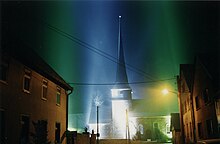
The largest church in Weimar is the city church of St. Peter and Paul , which was essentially built around 1500. It is also known as the Herder Church; this name goes back to the work of the theologian and philosopher Johann Gottfried Herder at the time of the Weimar Classic. The altarpiece was created by Lucas Cranach the Elder and the Younger .
The baroque Jakobskirche , the former court church, is the wedding church of Johann Wolfgang Goethe. The tombs of several famous personalities can be seen in her churchyard.
The Catholic Herz-Jesu-Kirche was built between 1889 and 1891 according to plans by the architect Max Meckel in the style of historicism . In its mixture of neo-Gothic and neo-renaissance , it is reminiscent of the model-giving cathedral of Florence .
The cruciform church was originally built in 1899 as the Church of Saint Michael and All Angels for Weimar's Anglican community at the time in the Anglican late Gothic style. When the congregation dissolved from 1914 onwards (since its mostly English members were considered to be Germany's opponents of the war and left the country), the church lost its task and stood empty. In 1927, Weimar's parish acquired the sacred building and rededicated it as a cruciform church in 1928. In 1962 it received bells from Apolda, and there has been a Schuke organ since 1989. It has recently been extensively renovated.
The Gelmeroda district has a village church that is known nationwide as the Feininger Church and the Autobahn Church .
Other structures
- Weimar Town Hall
- Weimar town house
- Renaissance buildings on the east side of the market, including with the Cranachhaus
- Escort inn, historic inn and one of the most beautiful half-timbered houses in Weimar
- Liszt House
- Bach House Weimar
- the Altenburg , once the home of Franz Liszt
- Kirms-Krackow-Haus
- Goethe's house with the Goethe National Museum
- Schiller's house with the Schiller Museum
- Goethe and Schiller monument
- Jacobsfriedhof Weimar with the cash register vault
- Park on the Ilm with Goethe's garden house, Roman house and park cave
- Historic cemetery with a princely crypt and a Russian Orthodox burial chapel
- Arts and crafts school building (workshop building of the former State Bauhaus in Weimar )
- Art school building (today the main building of the Bauhaus University Weimar)
- Villa Dürckheim , built in 1912/13 by Henry van de Velde
- Show house "Am Horn"
- House of high poplars
- Café Resi , the residence café, Weimar's oldest coffee house, centrally located between the market and the city palace
- the former Gauforum Weimar
- Capella "Vox coelestis" (built in 1899, Ehringsdorf cemetery)
- Fountain in Weimar
- Hafis-Goethe monument
- Heimrich table
- Lenin light box in the foyer of the La Redoute theater, the former seat of the Soviet military. The light box is a copy of a leaded glass window by Alexander Leonidovich Korolew.
Goethe's house on Frauenplan
Schiller's house on Schillerstrasse
Foundation walls of the Bach House , in which the composer Johann Sebastian Bach lived
Memorials
- Albert Schweitzer memorial and meeting place, museum in the Musäushaus
- Buchenwald Concentration Camp Memorial and Special Camp No. 2 Buchenwald
- Ernst Thälmann monument on Buchenwaldplatz
- Memorial to those who fell in March at the historical cemetery in Weimar
- Memorial in the main cemetery for the victims of the American bombing raids in 1945
- Memorial stone in the webicht for 149 prisoners murdered by the Gestapo
- Memorial plaque on the house of the Jewish families Ortweiler and Appel Am Brühl 6
- Jewish cemetery in Leibnizallee
- Death march stele at the corner of Ettersburger and Rießnerstraße
Museums
Art museums and galleries
Contemporary art is exhibited in the Neues Museum Weimar , an institution of the Weimar Classic Foundation. Regular exhibitions are shown in the Eigenheim gallery , the ACC gallery Weimar and the municipal art gallery Harry Graf Kessler.
The Bauhaus Museum contains exhibits from the Bauhaus art school founded in Weimar in 1919, including works by Walter Gropius and Johannes Itten . In 2019, the new Bauhaus Museum was opened adjacent to the Neue Weimarhalle and Gauforum, replacing the temporary structure on Theaterplatz.
The museum in the Weimar City Palace houses paintings from the 16th to 19th centuries .
History museums
The Thuringian State Office for Archaeological Monument Preservation maintains the Museum of Prehistory and Early History of Thuringia in Weimar .
The history of the city itself is presented in the city museum , which is located in the Bertuchhaus . The exhibition begins with traces of the earliest settlement and focuses on the work of Johann Sebastian Bach and Friedrich Justin Bertuch in Weimar as well as the National Assembly in 1919 and the Weimar Republic.
The House of the Weimar Republic on Theaterplatz commemorates the adoption of the Weimar Constitution in 1919.
The Weimarhaus , a private "history museum", shows important historical events in the form of entertaining dioramas.
Other museums
- In German bee museum all aspects of beekeeping should be considered.
- The Weimar Railway Museum is home to Thuringia's largest collection of historic locomotives.
- The Ginkgo Museum is engaged in only one of its kind with Ginkgopflanzen .
- The Pennewitz family's small umbrella museum is located in Rittergasse.
- The smallest museum in Weimar is dedicated to Marie Seebach on Tiefurter Allee. It served as a model for Giuseppe Verdi's Casa Verdi in Milan .
Media holdings
Archives
- Thuringian State Archives with the Thuringian Main State Archives
- Goethe and Schiller Archives
- Weimar City Archives
- Nietzsche archive
- Fürnberg archive
- Thuringian State Music Archive and University Archive
Libraries
- Duchess Anna Amalia library with military library
- University Library (UB) of the Bauhaus University
- Library of the University of Music
- Buchenwald Memorial Library
- library
- Green League environmental library
- Catholic Public Library
- GDR bookstore Taubach
Sports
societies
The city's best-known club is the SC 1903 Weimar football club , formerly Motor Weimar. During the GDR era, he mostly played in the GDR league (2nd division), briefly also in the Oberliga (1st division), and is currently in the Thuringian league . The home games are played in the football stadium Am Lindenberg , which is located on the arterial road towards Jena.
Weimar successes, with victories at the state, federal and GDR level or membership of the top division, there were in a surprising number of sports. One example of this is the white water canoeing in KGC 66 Weimar, which Weimar athletes had dominated in the GDR for a time. Weimar also has teams or individual athletes at a good amateur level in hockey, tennis , volleyball, chess , boxing, fencing, judo, basketball, gymnastics, table tennis, lifeguarding and senior football .
Sports facilities
Between the center and Weimar-West lies the largest concentration of sports facilities in the city, consisting of the Schwanseebad, Johannes swimming pool, Wimaria stadium, tennis grounds and three-field hall. There are also other facilities, such as the Falkenburg, a football hard court including a three-field hall, the boathouse as a canoeing center on the Ilm and the school sports halls that are open to clubs from the afternoon onwards.
Economy and Infrastructure
economy
Economic power
In the Future Atlas 2016 , the independent city of Weimar was ranked 108th out of 402 districts, municipal associations and independent cities in Germany. It is one of the regions with “future opportunities” and takes second place within Thuringia.
In 2016, Weimar achieved a gross domestic product (GDP) of € 2.001 billion within the city limits . In the same year, GDP per capita was € 31,147 (Thuringia: € 27,674 / Germany € 38,180). There were around 34,300 employed people in the city in 2017. The unemployment rate was 5.7% in December 2018, slightly above the Thuringian average of 5.2%.
In Weimar, 11.2 percent of employees work in the manufacturing industry and 87.7 percent in the service sector . 37.6 percent of this is attributable to gastronomy and retail alone. In 2002 there were 3,344 beds in 37 hotels in Weimar with a total of 435,677 overnight stays with an average length of stay of 1.9 days.
Industry
The largest industrial company is Bayer Weimar GmbH und Co. KG, a subsidiary of Bayer HealthCare , with around 500 employees. The site of the Weimar Waggonwerk, which was founded in 1898 and manufactured agricultural machinery as VEB Weimar-Werk during the GDR era , is now a site of the Hydrema Group, which manufactures construction machinery in Weimar.
A Coca-Cola bottling plant in Weimar, which emerged from the soft drinks manufacturer VEB Limona Weimar in 1991 , was closed in 2018.
During the GDR era, the VEB Uhrenwerk Weimar and the VEB Weimar-Werk existed in Weimar .
The Heerwagen organ building workshop was located in Weimar from 1896 to 1935 .
Services
Public facilities
The city is the seat of the Weimar District Court , which belongs to the district of the Erfurt Regional Court , the Weimar Administrative Court , the Thuringian Higher Administrative Court and the Thuringian Constitutional Court .
Tourism and meetings

Due to its history as well as numerous museums, galleries, monuments and cultural and classic sites, Weimar is an important destination for educational, cultural and city tourism . The memorial for the Buchenwald concentration camp with the special camp No. 2 Buchenwald is frequented by visitors from all over the world.
For example, the New Weimarhalle , which opened in 1999 , the Mon Ami youth cultural center , the riding house of the European Youth Education and Meeting Center Weimar (EJBW), the Other Music Academy building and several larger hotels offer event rooms for conferences, meetings, trade fairs, concerts and exhibitions .
Weimar has 28 hotels, including the historic Hotel Elephant , 6 youth hostels and backpacker hostels and a large number of guest houses and private accommodation.
There are campsites in Tiefurt , Ettersburg , Oettern and at the Hohenfelden reservoir .
media
- Seat of the Thuringian State Newspaper (TLZ). There is also a local edition of the Thüringer Allgemeine (Erfurt)
- Regional studio of the Central German Radio (Leipzig)
- Seat of the regional church newspaper Glaube + Heimat
- The former Faculty of Media at the Bauhaus University Weimar is in the Faculty of Art and Design risen
- Headquarters of the regional television broadcaster Salve.TV
- Headquarters of the local non-commercial radio broadcaster Radio Lotte
- The Bauhaus.FM facility is based at the Chair for Experimental Radio at the Bauhaus University Weimar
- Headquarters of the private radio stations Antenne Thüringen and Radio Top40
- Location of a free, self-administered and non-commercial WLAN network - Weimar network based on Freifunk
- Headquarters of the film producers Ostlicht Filmproduktionen GmbH, 1Meter60Film, Gruppe Weimar, Makido Film, Nivre Film & Studio GmbH
Energy industry
In 2014 Weimar was named an “ energy municipality” because the city was involved in the field of inter-municipal wind projects.
traffic
Foot traffic
Hiking trails
The Weimar Goethehaus is the starting point of the historic Goethe hiking trail to Großkochberg .
Bicycle traffic
Long-distance cycle routes
Weimar is located on the 124-kilometer Ilm Valley Cycle Path and is part of the Thuringian hiking trails network. Weimar is located on the Ilm cycle path , the Thuringian chain of cities and the Laura cycle path .
Road traffic
General trunk roads
The Weimar junction of the A 4 is the connection to the city, the Apolda exits from the east and Nohra from the west complement this. The federal highways 7 (west-east direction from Erfurt to Jena) and 85 (north-south direction from Bad Frankenhausen to Rudolstadt ) cross in the city. The B 7 coming from Erfurt today connects in a west-north direction to a partly two-lane north bypass. The continuation of the bypass road to the east towards Jena is controversial, as the Tiefurter Park , which is part of the world cultural heritage , would be crossed.
Scenic routes
The Thuringian Classic Road leads along the federal highway 7 through the Free State and passes Weimar as does the Thuringian-Bavarian beer and castle road along the federal highway 85 between Bad Frankenhausen and Passau.
Transportation
The city economy Weimar GmbH operates a city bus . The central transfer station at Goetheplatz is served by all nine city bus routes. Other important transfer stops are located at the main train station, in Gropiusstraße and at Wielandplatz. In the surrounding region, i.e. in Weimarer Land , local public transport is operated by the Weimarer Land company.
The Weimar tram operated in the city between 1899 and 1937 . Their line network with 1000 millimeters gauge was shut down in favor of buses and trolleybuses , so that Weimar is the largest city in the new federal states without a tram network. The Weimar trolleybus operation existed from 1948 to 1993. On April 1, 2006, the uniform network tariff for Central Thuringia was introduced in the cities of Erfurt, Jena, Weimar, Apolda and in the northern district of Weimarer Land .
Rail transport
The Thuringian Railway , the Ilmbahn and the Holzlandbahn meet in Weimar . The Weimar train station is part of the station category of third Weimar is mainly connected to long-distance traffic via the Erfurt ICE stop, which can be reached in less than 15 minutes by train. Only a few IC and ICE trains stop in Weimar itself.
In local transport, Weimar can be reached every two hours on the regional express train Göttingen- Erfurt-Weimar- Jena - Glauchau / Zwickau or Erfurt- Weimar-Jena- Gera / Altenburg , and the regional train Eisenach-Erfurt-Weimar- Naumburg- Halle (Saale) and the regional train Weimar– Kranichfeld important connections.
In the city area there is next to the main train station Weimar , the small Berka train station and five stops : Oberweimar, Weimar-West, Nohra (b Weimar), Holzdorf, Legefeld. Although not located on the Weimar corridor, the Obergrunstedt station is also part of the Weimar tariff area.
air traffic
The Weimar-Lindenberg airfield was built on June 8, 1911. From February 1919 the Deutsche Luft-Reederei flew a regular airmail service between Weimar and Berlin from here. Weimar – Berlin was one of the first civil airlines in the world and the first in Germany to be operated with airplanes. In 1936 the airfield on the Webicht was closed.
The airfield Weimar-Nohra was from 1917 to 1992 and was used by the military in particular.
The airfield Weimar-Umpferstedt can be served by small aircraft and helicopters, and among other things was the Chancellor used.
Since June 30, 2011, the Erfurt-Weimar airport near Erfurt has been offering holiday flight connections.
education
schools
- Grammar schools: "Friedrich Schiller" / "Johann Wolfgang v. Goethe ” / “ Humboldt ” / Belvedere Palace Music School
- Community school: State Community School Weimar / "Carl Zeiss"
- Regular schools: "Weimar-Schöndorf" / "Park School" / "Johann Heinrich Pestalozzi"
- Primary schools: "Johann Heinrich Pestalozzi" / "Louis Fürnberg" / "Johannes Falk" / "Albert Schweitzer" / "Park School" / "Lucas Cranach" / "Weimar-Schöndorf" / "Legefeld"
- Vocational schools: SBBS for economics, administration and nutrition "Friedrich Justin Bertuch" / State Vocational Training Center Weimar - (competence center for health, social affairs and technology), during the GDR era, among others. the medical college " Walter Krämer "
- Independent schools: Thuringia International School Weimar (ThIS) / Free Waldorf School Weimar / "Johannes Landenberger" School (special school for the mentally handicapped)
- Other schools: Thüringenkolleg Weimar (2nd educational path) / "Ottmar Gerster" music school / Herderschule (state regional support center) / Weimar Adult Education Center
Universities
- Bauhaus University Weimar (former Weimar Art Academy and, after 1945, University of Architecture and Construction ) with currently around 4,700 students in four faculties (architecture, civil engineering, design and media). The university's tradition goes back to its founding in 1860 as the Grand Ducal Saxon Art School in Weimar . In 1907 the Grand Ducal Saxon School of Applied Arts , founded by Henry van de Velde , was added. In 1919 Walter Gropius merged both schools and founded the State Bauhaus Weimar . The historical buildings have been part of the UNESCO World Heritage List since 1996 .
- Academy of Music Franz Liszt (with the built-in and with the University of Jena cooperating Department of Musicology Weimar-Jena ) with currently about 850 students and the associated Altenburg , the longtime home of Franz Liszt .
Literary Societies
- Goethe Society (Weimar, 1885)
- German Schiller Federation
- German Shakespeare Society
- Literary Society of Thuringia
- Thuringian Literature Council
people
Personalities
- Erich Kranz (1929–1999), pastor of the Jakobskirche from 1977 to 1994 , has been an honorary citizen of Weimar since 1991 .
- On October 3, 2009, Bertrand Herz , President of the International Buchenwald-Dora Committee , became an honorary citizen of Weimar.
- On March 1, 2021, Günter Pappenheim , Buchenwald survivor, became an honorary citizen of Weimar
Weimarer, Weimaraner
The inhabitants of Weimar are known as Weimar residents . Johann Wolfgang von Goethe called them Weimaraner . Weimaraner is now also the name of a breed of dog that was bred here in the 19th century. Both Weimar (then mostly in relation to the city) and Weimar / -r / -s (then mostly in relation to the state of Sachsen-Weimar / Sachsen-Weimar-Eisenach ) are used adjectivally or adverbially (e.g. Weimarer Mayor, Weimar State Council).
Vimaria
The Latinized form of the city name of Weimar Vimaria is not only a personification of the city of Weimar but also the patron saint, among others. a sports club, a publisher of a former ornamental fountain.
reception
The Weimar ice cusp is an ice cusp in the Antarctic.
literature
- Alexandra Abel (text), Stephan Ernst (photo): Classic Modern Lifestyles in Weimar. Weimarer Verlagsgesellschaft, Weimar 2015, ISBN 978-3-7374-0212-5 .
- Dorothee Ahrendt (text), Roland Krawulsky (photo): Weimarer Parks. Edition Leipzig, Leipzig 2013, ISBN 978-3-361-00684-3 .
- Günther Beyer (pictures) and Jens Riederer (texts): Pictures of Destruction. Weimar 1945. Catalog for the special exhibition in the Stadtmuseum Weimar, published by the Stadtmuseum, Weimar 2015, ISBN 978-3-910053-57-1 .
- Andrea Dietrich, Jörg Sauerbier: Weimar. Views and insights. Leipzig 1996, ISBN 3-86189-082-8 .
- Gitta Günther , Wolfram Huschke, Walter Steiner (eds.): Weimar. Lexicon on the history of the city. Weimar 1998, ISBN 3-7400-0807-5 .
- Jürgen Helfricht : Little Weimar ABC. Husum Verlag, Husum 2008, ISBN 978-3-89876-387-5 .
- Hannelore Henze , Ilse-Sibylle Stapff: Forays through old Weimar. Wartburg-Verlag, Weimar 2004, ISBN 3-86160-156-7 .
- Rikola-Gunnar Lüttgenau (Ed.): Weimar in National Socialism. A city guide. Förderverein Buchenwald, Weimar 2008, ISBN 978-3-938669-04-4 .
- Peter Merseburger : Myth Weimar. Between mind and power. dtv, 2013, ISBN 3-423-30787-0 .
- Rainer Müller: Monument topography Federal Republic of Germany - cultural monuments in Thuringia (Volume 4). City of Weimar, old town (volume 4.1), city of Weimar, urban expansion and districts (volume 4.2). E. Reinhold Verlag, Altenburg 2010, ISBN 978-3-937940-54-0 .
- Angela Pfotenhauer, Elmar Lixenfeld: Weimar - World Heritage. Monuments edition. Monuments publication of the German Foundation for Monument Protection, Bonn 2006, ISBN 3-936942-65-X or ISBN 3-936942-66-8 .
- Heinrich Pleticha (ed.): The classic Weimar. Texts and certificates. Cologne 1983, ISBN 3-89836-517-4 .
- Steffen Raßloff : History of the city of Weimar. Erfurt 2018, ISBN 978-3-95400-891-9 .
- Steffen Raßloff and Mark Schmidt (eds.): Places of the Reformation - Weimar. Leipzig 2015, ISBN 978-3-374-04117-6 .
- Rolf Schneider : Weimar. Classic and modern. be.bra verlag, Berlin 2012, ISBN 978-3-86124-661-9 .
- Alberto Schwarz: Weimar (= " Famous Art Places / Art History City Books "). Leipzig 1993, ISBN 3-363-00582-2 .
- Annette Seemann : Weimar - a travel companion. Insel Verlag, 2004, ISBN 3-458-34766-6 .
- Annette Seemann, Constantin Beyer: Weimar. The most important buildings from the Middle Ages to the present. Mitteldeutscher Verlag, Halle (Saale) 2014, ISBN 978-3-95462-193-4 (picture-text volume).
- Justus H. Ulbricht : Classic City and National Socialism, Culture and Politics in Weimar 1933 to 1945. Weimar 2000, ISBN 3-931743-55-1 .
- Rainer Wagner (Ed.): Weimar. Cityscapes in Transition. Kassel 1992, ISBN 3-87816-078-X .
- Weimar and its surroundings (= values of our homeland . Volume 18). 1st edition. Akademie Verlag, Berlin 1973.
- Weimar and its surroundings (= values of the German homeland . Volume 61). 2nd Edition. Verlag Hermann Böhlaus successor, Weimar 1999, ISBN 3-7400-0941-1 .
Web links
- Official websites
- Other websites
- Historical city tour at Wimare.de
- Alt-Weimar in views by Georg Melchior Kraus
- Illustration of the city 1581 in Civitates orbis terrarum by Georg Braun
- Link catalog on the subject of Weimar at curlie.org (formerly DMOZ )
- The wine festival in Weimar. (No longer available online.) In: weimar-in.de. Archived from the original on December 14, 2015 .
- The Weimar song by Günter von Dreyfuß
- Manfred Kiedorf: Ear you nymphs who live in the trees - two painting bohemians in Weimar in the 50s. (No longer available online.) In: mdr.de. MDR, August 29, 1993, archived from the original on April 7, 2016 (original sound feature by and with Manfred Kiedorf; 59:03 min .; mp3; 54.1 MB ; mp4; 107.7 MB ).
- Historical and contemporary views of Weimar's buildings
Individual evidence
- ↑ Population of the communities from the Thuringian State Office for Statistics ( help on this ).
- ↑ The decision was made on the basis of the “great art-historical importance of public and private buildings and park landscapes from the heyday of classical Weimar.” See Classical Weimar. (No longer available online.) In: unesco.de. German UNESCO Commission V., archived from the original on June 4, 2016 ; accessed on December 31, 2018 .
- ↑ bundestag.de
- ↑ Hydrogeological map of Thuringia from the Thuringian State Institute for Environment and Geology (PDF; 4.37 MB) ( Even finer maps are available for each district .)
- ↑ Weimar. Lexicon on the history of the city. P. 143 ff.
- ↑ Axel Stefek: Weimar underground - The Lottenbach and the trenches as historical city waters , from "Weimar - Jena: The big city" 4/4 (2011) pp. 241-261, Verlag Vopelius. In: www.VerlagVopelius.eu
- ↑ Bemman / Hahne, p. 35, with further literature.
- ^ German book of place names. Edited by Manfred Niemeyer. De Gruyter, Berlin / Boston 2012, p. 677.
- ↑ Weimar. Lexicon on the history of the city. P. 91.
- ↑ Weimar. Lexicon on the history of the city. P. 293.
- ↑ See Rudolf Feustel (Ed.): Alt-Thüringen (= annual publication of the Museum of Prehistory and Early History of Thuringia. Volume 15). Weimar 1978. Therein: Günther Röblitz: The stamp of the Weimar Mint (table p. 111). (PDF; 828 kB).
- ↑ Ronald Füssel: The witch persecutions in the Thuringian area (= publications of the working group for historical witchcraft and crime research in Northern Germany. Volume 2). DOBU, Wiss. Publication Documentation and Book, Hamburg 2003, ISBN 3-934632-03-3 , pp. 247 f. (Zugl .: Marburg, Univ., Diss., 2000).
- ^ Wilhelm Möller: Places of execution and executions in the city of Weimar (= contributions to the history of the city of Weimar. Issue 21). Bimaria Verlag, Weimar, p. 21.
- ↑ Weimar. Lexicon on the history of the city. P. 73
- ↑ Weimar. Lexicon on the history of the city. P. 477 f.
- ↑ Weimar. Lexicon on the history of the city. P. 276.
- ↑ Weimar. Lexicon on the history of the city. P. 496.
- ↑ Historical Lexicon of Bavaria - Hitler Youth.
- ^ Gitta Günther, Wolfram Huschke, Walter Steiner (eds.): Weimar. Lexicon on the history of the city. Weimar 1998, ISBN 3-7400-0807-5 , p. 383.
- ↑ To commemorate this event, a commemorative plaque was attached to the outer facade of the “Crossbow”. However, this was removed again after the Second World War in 1945.
- ↑ Jens Schley: Neighbor Buchenwald. The city of Weimar and its concentration camp 1937–1945. Cologne / Weimar / Vienna 1999, ISBN 3-412-15298-6 , p. 12.
- ↑ Guido Dressel: Sources on the history of Thuringia. 75 years of the Free State of Thuringia. Elections and voting results 1920–1995. P. 100 ff.
- ↑ Among them are two people that suicide committed; 3 people who died as a result of imprisonment; 1 person who was killed in the Bernburg killing center and 9 people who were pronounced dead . Memorial book. Search in the name directory. Search for: Weimar - Residence. In: bundesarchiv.de, accessed on April 16, 2017.
- ↑ Manfred Hartung: The settlement of the military in Weimar-Nord , pdf (8 pages) from March 2017, accessed on October 12, 2019
- ↑ Michael Baar: With Weimar's cattle auction hall, a place of remembrance burned down. In: thueringer-allgemeine.de, April 22, 2015, accessed on December 31, 2018 (beginning of the article freely available).
- ↑ Jorge Semprún in the "Glocke vom Ettersberg" II / 1997, p. 11.
- ^ The liberation of the Buchenwald concentration camp. (No longer available online.) In: kriegsende.ard.de. Archived from the original on April 28, 2009 ; accessed on December 31, 2018 .
- ^ Modern military archives, Washington, 4th armored division, 604-2.2-daily reports, June 1944-May 1945.
- ^ Protest against marches. In: Thüringische Landeszeitung. February 8, 2013.
- ↑ a b Joachim Lattke: At lunchtime everything sank into rubble. In: Thüringische Landeszeitung. February 9, 2013.
- ↑ Commemoration of bomb victims. In: Thüringische Landeszeitung. February 10, 2012.
- ↑ youtube.com The Wehrmacht Series 5: To the Bitter End Part 5 of 6
- ↑ Secret report of the Erfurt district authority of the People's Police from June 29, 1953 on the events on June 17 and the following days. In: 17juni53.de, accessed on November 8, 2016.
- ↑ Axel Stefek : Protest rally in the dining room - the “17th June “in Weimar. In: Axel Stefek: Weimar unadjusted. Resistant behavior 1950–1989. Stadtmuseum Weimar, Weimar 2014, pp. 39–44, here p. 42.
- ↑ The cry for freedom. June 17, 1953 in Thuringia. Catalog for the exhibition of the Ettersberg Foundation on the 50th anniversary of June 17, 1953. Last shown in the Thuringian Parliament in Erfurt in June 2012.
- ↑ Axel Stefek: death sentences for two Weimar residents. In: Axel Stefek: Weimar unadjusted. Resistant behavior 1950–1989. Stadtmuseum Weimar, Weimar 2014, pp. 23–28.
- ↑ Axel Stefek: Weimar unadjusted. Resistant behavior 1950–1989. Stadtmuseum Weimar, Weimar 2014, pp. 73–136.
- ↑ Heinz Voigt: Motto '89: "Seek the city's best ..." Memories of the times of upheaval and new beginnings - On the death of the Weimar pastor Erich Kranz. (No longer available online.) In: horch-und-guck.info. Horch and Guck , 1999, pp. 20-21 , archived from the original on December 2, 2013 ; accessed on December 31, 2018 (issue 25/1999).
- ↑ Christoph Victor : October spring. The turning point in Weimar. Edited by the Weimar City Museum. 1992 and 2009, ISBN 3-910053-25-4 .
- ↑ Stefan Schulz: Example Weimar. In: Berliner Morgenpost. November 19, 2002 (only available to online subscribers).
- ↑ City council election in Weimar 2019 In: wahlen.thueringen.de .
- ↑ Election of the district administrators and mayors of the urban districts 2018: District-free city 054 City of Weimar. Regional Returning Officer Thuringia, accessed on July 1, 2018 .
- ↑ Thorsten Büker: Weimar coalition wants to stay on course until 2019. In: weimar.tlz.de. Thüringische Landeszeitung, January 21, 2015, accessed on March 1, 2018.
- ↑ Weimar's city leaders since 1793. In: stadt.weimar.de, accessed on April 17, 2018.
- ↑ Weimar. Lexicon on the history of the city. P. 427.
- ↑ Peter Rathay: Weimar enters into partnership with Zamosc in Poland. In: Thuringian General. May 26, 2012. Retrieved July 25, 2019.
- ↑ See Weimar Rendezvous with History. Website.
- ↑ International Student Film Festival backup.
- ↑ Summer of Music. Venues. (No longer available online.) In: mdr.de. Archived from the original on December 3, 2013 ; accessed on December 31, 2018 .
- ↑ Where the shows are at home. The Weimar City Hall. (No longer available online.) In: mdr.de. Archived from the original on December 2, 2013 ; accessed on December 31, 2018 .
- ↑ see e.g. B. Gitta Günther, Wolfram Huschke, Walter Steiner (eds.): Weimar - Lexicon for city history. Springer-Verlag, 2017, p. 201
- ↑ Also Goethe Hafis Monument.
- ↑ leninisstillaround.com
- ↑ weimar.de - Tourism: Bauhaus Museum. ( Memento from November 9, 2016 in the Internet Archive ) In: weimar.de, accessed on November 8, 2016.
- ^ Bauhaus Museum Weimar. In: klassik-stiftung.de, accessed on November 8, 2016.
- ↑ Weimar is building a new Bauhaus museum. In: zeit.de. Retrieved September 18, 2013 .
- ^ Library of the University of Music.
- ^ Library of the Buchenwald Memorial.
- ^ GDR bookstore Taubach. Retrieved August 19, 2011 .
- ↑ Future Atlas 2016. (No longer available online.) In: prognos.de. Archived from the original on August 9, 2016 ; accessed on March 23, 2018 .
- ↑ Current results - VGR dL. In: statistik-bw.de. Retrieved January 7, 2019 .
- ^ Federal State of Thuringia. In : arbeitsagentur.de. Federal Employment Agency, accessed on January 7, 2019 .
- ^ Weimar: Engaged in wind projects. 29th August 2014.
- ↑ Transport. Retrieved August 19, 2020 .
- ↑ About us. Retrieved August 19, 2020 .
- ↑ In 2005, the main station was named “Station of the Year” in the “Small and Medium-Sized Cities” category by the Pro Schiene Alliance .
- ↑ fsv-rudolstadt.de
- ↑ mdr.de
- ↑ history-weimar.de
- ↑ Flugplatz-nohra.de
- ↑ thueringer-allgemeine.de
- ↑ FOCUS NWMI-OFF / City of Weimar: Musäus regular school becomes the state community school "Carl Zeiss". (No longer available online.) In: focus.de. August 10, 2017, archived from the original on September 7, 2017 ; accessed on July 25, 2019 .
- ↑ Christoph Victor (ed.): The courage to walk upright - memories of the Weimar pastor and honorary citizen Erich Kranz. Weimar 2013.
- ↑ Christiane Weber: 300 years of Weimar Jakobskirche: Pastor Erich Kranz honored with a book. In: tlz.de. Thüringische Landeszeitung, October 31, 2013, accessed on July 25, 2019 .
- ↑ Belief rooms . Jakobskirche Weimar. Church service, concerts, readings & projects 2013. Published by the Evangelical Lutheran Church Community Weimar / Luthersprengel, p. 10; online in: kirchenkreis-weimar.de, accessed on 23 August 2017 ( PDF; 967 kB ).
- ↑ Notes on awarding honorary citizenship. Prize winner ( memento from July 19, 2011 in the Internet Archive ). In: weimar.de, accessed on November 8, 2016.
- ↑ All honorary citizens of the city of Weimar
- ↑ Johann Wolfgang von Goethe: Zahme Xenien 5 at Zeno.org . ("Am Weimaraner").









